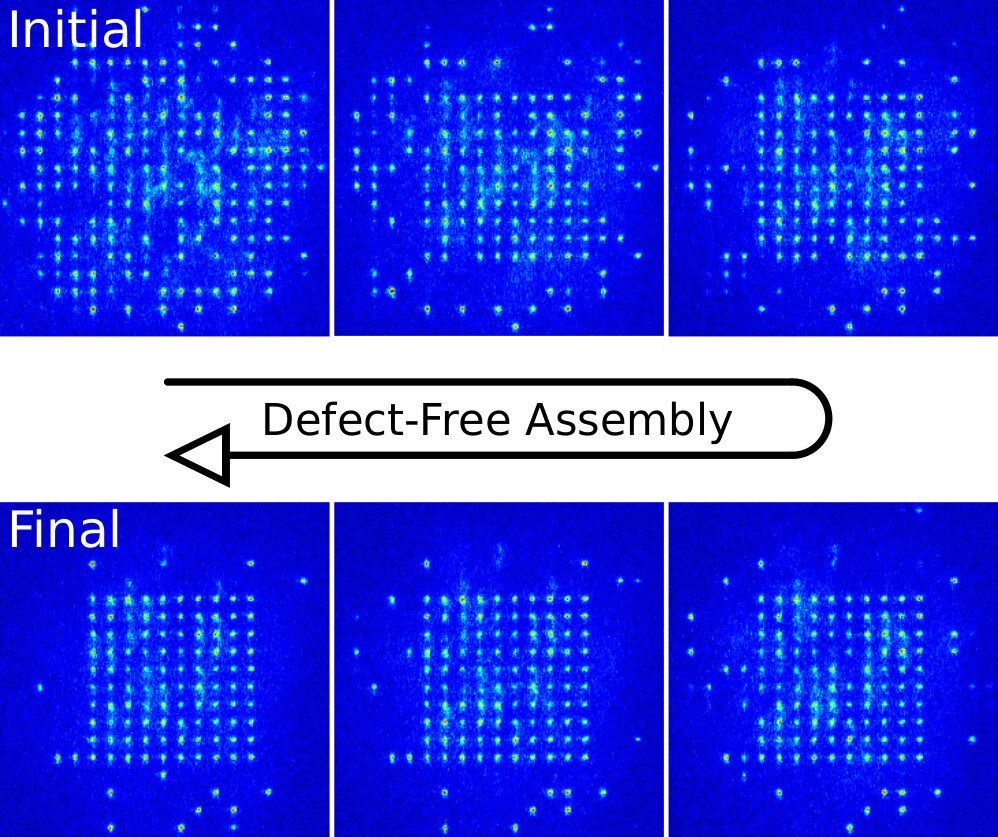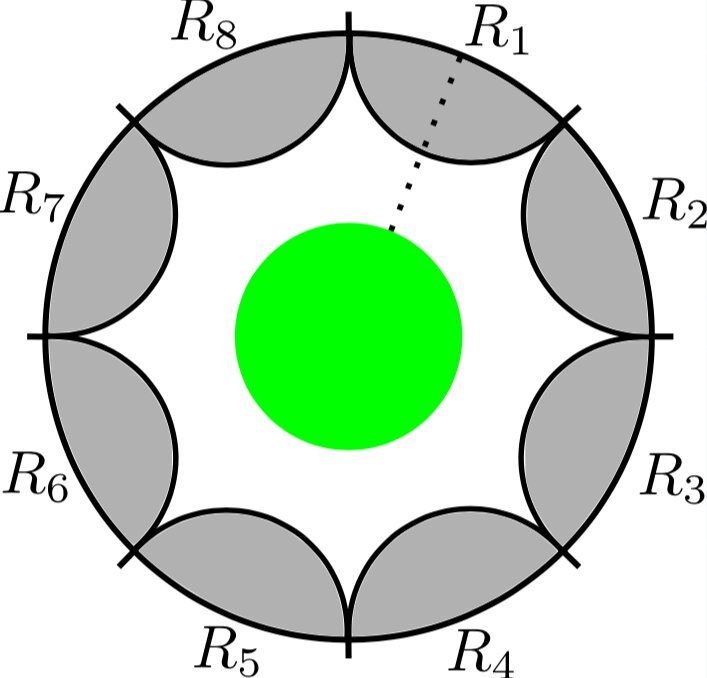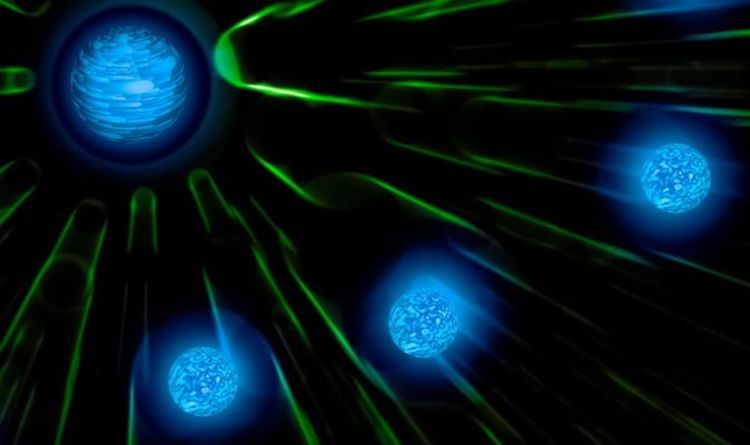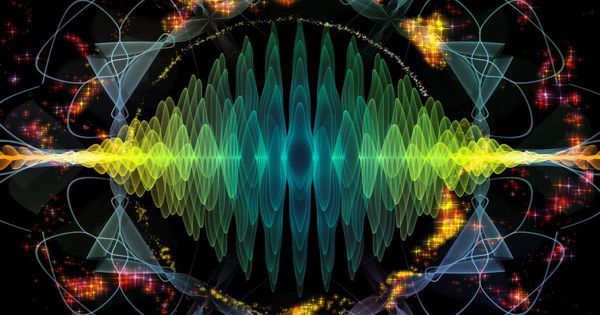Is up at Cosmoquest.



Researchers at Technische Universität Darmstadt have recently demonstrated the defect-free assembly of versatile target patterns of up to 111 single-atom quantum systems. Their findings, outlined in a paper published in Physical Review Letters, could drive assembled-atom architectures beyond the threshold of quantum advantage, paving the way for new breakthroughs in quantum science and technology.
“Our research is driven by the observation that physical sciences are right in the middle of a paradigm shift in which the application of quantum physics, i.e. quantum technologies, are becoming the leading technologies in the near future,” Gerhard Birkl, one of the researchers who carried out the study, told Phys.org. “A vast list of applications are already foreseeable but I am convinced that of most applications we are not even aware of.”
The next step for the field of quantum science and technology is the development of experimental platforms that offer extensive scalability, multisite quantum correlations and efficient quantum error correction. Over the past century or so, researchers have carried out a substantial amount of work on single quantum systems, laying the foundations for current developments. Atomic quantum systems have played a key role in these studies, particularly neutral atoms trapped by light, as they provide well-isolated quantum systems with favorable scaling.

The quotation marks had the force of tradition—and the tradition of force—behind them.
When Nebraska’s Herman Batelaan and colleagues recently submitted a research paper that makes the case for the existence of a non-Newtonian, quantum force, the journal asked that they place “force” firmly within quotes. The team understood and agreed to the request.
After all, the word has long belonged to classical Newtonian physics: equal-and-opposite reactions, electromagnetism, gravity and other laws that explain the apple-dropping, head-bonking phenomena of everyday experience.

A pair of researchers, one at the Massachusetts Institute of Technology (MIT) and another at California Institute of Technology (Caltech) and the University of Tokyo, have recently investigated a set of old conjectures about symmetries in quantum gravity. The specific conjectures of focus: Quantum gravity does not allow for global symmetries; For gauge symmetry, all possible charges must be realized; Internal gauge groups must be compact. Their paper, published in Physical Review Letters, shows that these old assumptions hold within the anti-de Sitter/conformal field theory (AdS-CFT) correspondence.
“Historically, the concept of symmetry has played important roles in physics, both in identifying and formulating fundamental laws of nature, and in using these laws to understand and predict natural phenomena such as dynamics and phases of matters,” Hirosi Ooguri, one of the researchers who carried out the study, told Phys.org. “However, there has been theoretical evidence to suggest that, once we combine gravity and quantum mechanics (the two fundamental ideas in modern physics), all global symmetries are gone.”
In physics, symmetries can be of two kinds: gauge and global. For several decades, researchers have proposed the idea that global symmetries should not be possible in quantum gravity, as the unified theory of gravity and quantum mechanics would not allow for any symmetry. This is a profound claim with important consequences. For instance, it predicts that a proton would not be stable against decaying into other particles.

Astronomers have carried out a multiwavelength investigation of a pulsar wind nebula (PWN), designated DA 495, to unveil its mysterious physical nature. Results of the study, based on observations using HAWC and VERITAS ground-based observatories as well as NASA’s NuSTAR spacecraft, are presented in a paper published May 17 on arXiv.org.
Pulsar wind nebulae (PWNe) are nebulae powered by the wind of a pulsar. Pulsar wind is composed of charged particles; when it collides with the pulsar’s surroundings, in particular with the slowly expanding supernova ejecta, it develops a PWN.
Particles in PWNe lose their energy to radiation and become less energetic with distance from the central pulsar. Multiwavelength studies of these objects, including X-ray observations, especially using spatially-integrated spectra in the X-ray band, have the potential of uncovering important information about particle flow in these nebulae. This could unveil important insights into the nature of PWNe in general.

Scientist have just discovered that, at an atomic level, these elements have both liquid and solid states, giving context to what may be hidden in the cores of celestial bodies.
A New State of Water Reveals a Hidden Ocean in Earth’s Mantle — https://youtu.be/pgm4z8vJVVk
On the chain-melted phase of matter
https://www.pnas.org/content/116/21/10297
“We develop here a classical interatomic forcefield for the element potassium using machine-learning techniques and simulate the chain-melted state with up to 20,000 atoms. We show that in the chain-melted state, guest-atom correlations are lost in three dimensions, providing the entropy necessary for its thermodynamic stability.”
Elements can be solid and liquid at same time
https://www.ed.ac.uk/news/2019/elements-can-be-solid-and-liquid-at-same-time
“A team led by scientists from the University of Edinburgh used powerful computer simulations to study the existence of the state – known as the chain-melted state. Simulating how up to 20,000 potassium atoms behave under extreme conditions revealed that the structures formed represent the new, stable state of matter. Applying pressure to the atoms leads to the formation of two interlinked solid lattice structures, the team says.”
Information on Alkali Metals
“Alkali metals react with water to produce heat, hydrogen gas, and the corresponding metal hydroxide. The heat produced by this reaction may ignite the hydrogen or the metal itself, resulting in a fire or an explosion. The heavier alkali metals will react more violently with water.“
____________________
Elements is more than just a science show. It’s your science-loving best friend, tasked with keeping you updated and interested on all the compelling, innovative and groundbreaking science happening all around us. Join our passionate hosts as they help break down and present fascinating science, from quarks to quantum theory and beyond.

Some research topics, says conventional wisdom, a physics PhD student shouldn’t touch with an iron-tipped medieval lance: sinkholes in the foundations of quantum theory. Problems so hard, you’d have a snowball’s chance of achieving progress. Problems so obscure, you’d have a snowball’s chance of convincing anyone to care about progress. Whether quantum physics could influence cognition much.
Quantum physics influences cognition insofar as (i) quantum physics prevents atoms from imploding and (ii) implosion inhabits atoms from contributing to cognition. But most physicists believe that useful entanglement can’t survive in brains. Entanglement consists of correlations shareable by quantum systems and stronger than any achievable by classical systems. Useful entanglement dies quickly in hot, wet, random environments.
Brains form such environments. Imagine injecting entangled molecules A and B into someone’s brain. Water, ions, and other particles would bombard the molecules. The higher the temperature, the heavier the bombardment. The bombardiers would entangle with the molecules via electric and magnetic fields. Each molecule can share only so much entanglement. The more A entangled with the environment, the less A could remain entangled with B. A would come to share a tiny amount of entanglement with each of many particles. Such tiny amounts couldn’t accomplish much. So quantum physics seems unlikely to affect cognition significantly.



Quantum physics, the study of the universe on an atomic scale, gives us a reference model to understand the human ecosystem in the discrete individual unit. It helps us understand how individual human behavior impacts collective systems and the security of humanity.
Metaphorically, we can see this in how a particle can act both like a particle or a wave. The concept of entanglement is at the core of much of applied quantum physics. The commonly understood definition of entanglement says that particles can be generated to have a distinct reliance on each other, despite any three-dimensional or 4-dimensional distance between the particles. What this definition and understanding imply is that even if two or more particles are physically detached with no traditional or measurable linkages, what happens to one still has a quantifiable effect on the other.
Now, individuals and entities across NGIOA are part of an entangled global system. Since the ability to generate and manipulate pairs of entangled particles is at the foundation of many quantum technologies, it is important to understand and evaluate how the principles of quantum physics translate to the survival and security of humanity.